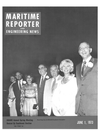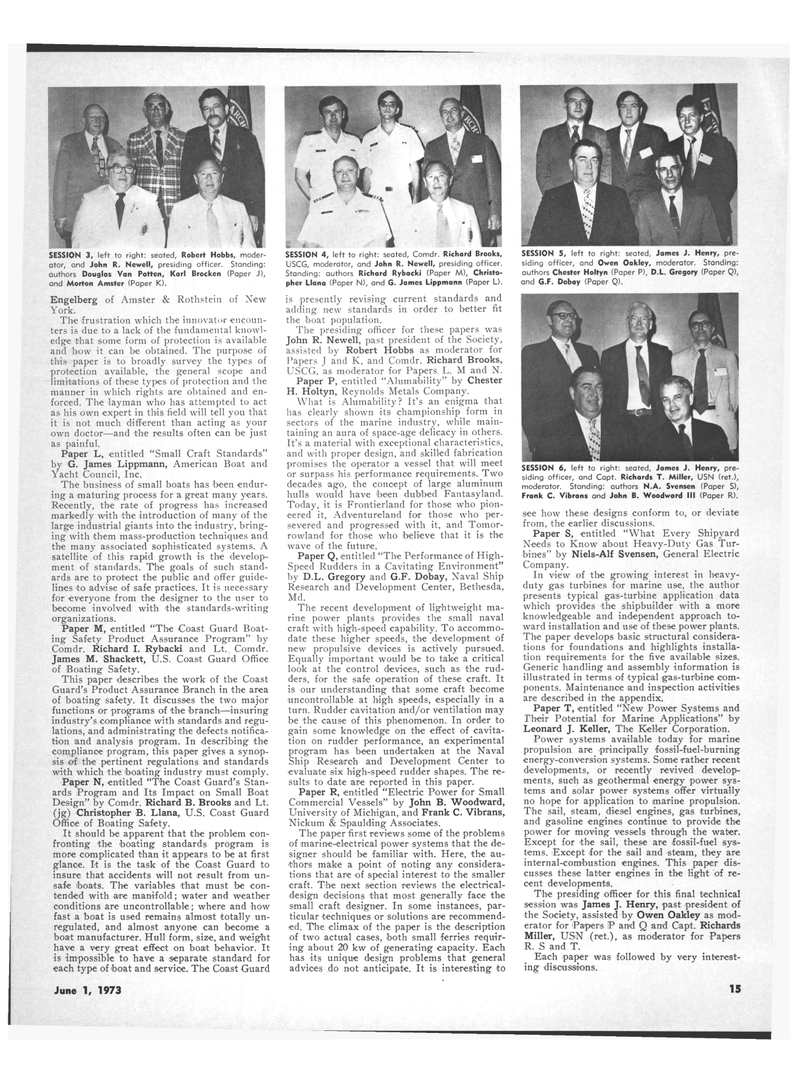
Page 13: of Maritime Reporter Magazine (June 1973)
Read this page in Pdf, Flash or Html5 edition of June 1973 Maritime Reporter Magazine
SESSION 3, left to right: seated, Robert Hobbs, moder- ator, and John R. Newell, presiding officer. Standing: authors Douglas Van Patten, Karl Brocken (Paper J), and Morton Amster (Paper K).
SESSION 4, left to right: seated, Comdr. Richard Brooks,
USCG, moderator, and John R. Newell, presiding officer.
Standing: authors Richard Rybacki (Paper M), Christo- pher Liana (Paper N), and G. James Lippmann (Paper L).
Engelberg of Amster & Rothstein of New
York.
The -frustration which the innovator encoun- ters is due to a lack of the fundamental knowl- edge that some form of protection is available and 'bow it can be obtained. The purpose of this paper is to broadly survey the types of protection available, the general scope and limitations of these types of protection and the manner in which rights are obtained and en- forced. The layman who has attempted to act as his own expert in this field will tell you that it is not much different than acting as your own doctor—and the results often can be just as painful.
Paper L, entitled "Small Craft Standards" by G. James Lippmann, American Boat and
Yacht Council, Inc.
The business of small boats has been endur- ing a maturing process for a great many years.
Recently, the rate of progress has increased markedly with the introduction of many of the large industrial giants into the industry, bring- ing with them mass-production techniques and the many associated sophisticated systems. A satellite of this rapid growth is the develop- ment of standards. The goals of such stand- ards are to protect the public and offer guide- lines to advise of safe practices. It is necessary for everyone from the designer to the user to become involved with the standards-writing organizations.
Paper M, entitled "The Coast Guard Boat- ing Safety Product Assurance Program" by
Comdr. Richard I. Rybacki and Lt. Comdr.
James M. Shackett, U.S. Coast Guard Office of Boating Safety.
This paper describes the work of the Coast
Guard's Product Assurance Branch in the area of boating safety. It discusses the two major functions or programs of the branch—insuring industry's compliance with standards and regu- lations, and administrating the defects notifica- tion -and analysis program. In describing the compliance program, this paper gives a synop- sis of the pertinent regulations and standards with which the boating industry must comply.
Paper N, entitled "The Coast Guard's Stan- ards Program and Its Impact on Small Boat
Design" by Comdr. Richard B. Brooks and Lt. (jg) Christopher B. Liana, U.S. Coast Guard
Office of Boating Safety.
It should be apparent that the problem con- fronting the boating standards program is more complicated than it appears to be at first glance. It is the task of the Coast Guard to insure that accidents will not result from un- safe boats. The variables that must be con- tended with are manifold; water and weather conditions are uncontrollable; where and how fast a boat is used remains almost totally un- regulated, and almost anyone can become a boat manufacturer. Hull form, size, and weight have a very great effect on boat behavior. It is impossible to have a separate standard for each type of boat and service. The Coast Guard
June 1, 1973 is presently revising current standards and adding new standards in order to better fit the boat population.
The presiding officer for these papers was
John R. Newell, past president of the Society, assisted by Robert Hobbs as moderator for
Papers J and K. and Comdr. Richard Brooks,
USCG, as moderator for Papers L. M and N.
Paper P, entitled "Alumability" by Chester
H. Holtyn, Reynolds Metals Company.
What is Alumability? It's an enigma that has clearly shown its championship form in sectors of the marine industry, while main- taining an aura of space-age delicacy in others.
It's a material with exceptional characteristics, and with proper design, and skilled fabrication promises the operator a vessel that will meet or surpass his performance requirements. Two decades ago, the concept of large aluminum hulls would have been dubbed Fantasyland.
Today, it is Frontierland for those who pion- eered it, Adventureland for those who per- severed and progressed with it, and Tomor- rowland for those who believe that it is the wave of the future.
Paper Q, entitled "The Performance of High-
Speed Rudders in a Cavitating Environment" by D.L. Gregory and G.F. Dobay, Naval Ship
Research and Development Center, Bethesda,
Md.
The recent development of lightweight ma- rine power plants provides the small naval craft with high-speed capability. To accommo- date these higher speeds, the development of new propulsive devices is actively pursued.
Equally important would be to take a critical look at the control devices, such as the rud- ders, for the safe operation of these craft. It is our understanding that some craft become uncontrollable at high speeds, especially in a turn. Rudder cavitation and/or ventilation may be the cause of this phenomenon. In order to gain some knowledge on the effect of cavita- tion on rudder performance, an experimental program has been undertaken at the Naval
Ship Research and Development Center to evaluate six high-speed rudder shapes. The re- sults to date 'are reported in this paper.
Paper R, entitled "Electric Power for Small
Commercial Vessels" by John B. Woodward,
University of Michigan, and Frank C. Vibrans,
Nickum & Spaulding Associates.
The paper first reviews some of the problems of marine-electrical power systems that the de- signer should be familiar with. Here, the au- thors make a point of noting any considera- tions that are of special interest to the smaller craft. The next section reviews the electrical- design decisions that most generally face the small craft designer. In some instances, par- ticular techniques or solutions are recommend- ed. The climax of the paper is the description of two actual cases, both small ferries requir- ing about 20 kw of generating capacity. Each has its unique design problems that general advices do not anticipate. It is interesting to
SESSION 5, left to right: seated, James J. Henry, pre- siding officer, and Owen Oakley, moderator. Standing: authors Chester Holtyn (Paper P), D.L. Gregory (Paper Q), and G.F. Dobay (Paper Q).
SESSION 6, left to right: seated, James J. Henry, pre- siding officer, and Capt. Richards T. Miller, USN (ret.), moderator. Standing: authors N.A. Svensen (Paper S),
Frank C. Vibrans and John B. Woodward III (Paper R). see how these designs conform to, or deviate from, the earlier discussions.
Paper S, entitled "What Every Shipyard
Needs to Know about Heavy-Duty Gas Tur- bines" by Niels-Alf Svensen, General Electric
Company.
In view of the growing interest in heavy- duty gas turbines for marine use, the author presents typical gas-turbine application data which provides the shipbuilder with a more knowledgeable and independent approach to- ward installation and use of these power plants.
The paper develops basic structural considera- tions for foundations and highlights installa- tion requirements for the five available sizes.
Generic handling and assembly information is illustrated in terms of typical gas-turbine com- ponents. Maintenance and inspection activities are described in the appendix.
Paper T, entitled "New Power Systems and
Their Potential for Marine Applications" by
Leonard J. Keller, The Keller Corporation.
Power systems available today for marine propulsion are principally fossil-fuel-burning energy-conversion systems. Some rather recent developments, or recently revived develop- ments, such as geothermal energy power sys- tems and solar power systems offer virtually no hope for application to marine propulsion.
The sail, steam, diesel engines, gas turbines, and gasoline engines continue to provide the power for moving vessels through the water.
Except for the sail, these are fossil-fuel sys- tems. Except for the sail and steam, they are internal-combustion engines. This paper dis- cusses these latter engines in the light of re- cent developments.
The presiding officer for this final technical session was James J. Henry, past president of the Society, assisted by Owen Oakley as mod- erator for Papers P and Q and Capt. Richards
Miller, USN (ret.), as moderator for Papers
R. S and T.
Each paper was followed by very interest- ing discussions. 15

 12
12

 14
14
